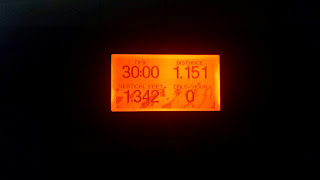I have been outside a few times.
Trail Running in foot deep powder snow at -1F - STORY HERE
Quandary in a Snow Storm - STORY HERE
Ice Climbing Solo - STORY HERE
But I have been on the treadmill a lot. I wear my SUUNTO Ambit 2S and keep track of my stats, and use my Incline Treadmill Calculator (HERE) and record my training logs. Here's a sample for you:
Monday 10th
ITM:
Time: 15:54
Distance: 1.001
Incline: 1.5%
Elevation Gain: 79.28'
Average MPH: 3.777
Average Pace: 15:53
Vertical/Hour: 299'
Vertical/Minute: 4.99'
VAM: 91.2
ITM:
Time: 32:18
Distance: 2.202
Incline: 3%
Elevation Gain: 348.80'
Average MPH: 4.09
Average Pace: 14:40
Vertical/Hour: 648'
Vertical/Minute: 10.8'
VAM: 197.5
Tuesday 11th
Ice Climbing:
3.0 mi Distance
24:14 Moving Time
589 ft
(going too slow to register in Strava)
Wednesday 12th
Outside:
Gulch
5.1mi
1:19:58 Moving Time
15:35/mi Pace
114 Tough Suffer Score
Elevation 619 ft
Calories 863
Elapsed Time 1:27:13
Thursday 13th
ITM:
Time: 63:09
Distance: 5.017
Incline: 1%
Elevation Gain: 264.90'
Average MPH: 4.767
Average Pace: 12:35
Vertical/Hour: 252'
Vertical/Minute: 4.19'
VAM: 76.7
That's a good mix I think for a normal winter. So far this week.
ITM:
Time: 15:54
Distance: 1.001
Incline: 1.5%
Elevation Gain: 79.28'
Average MPH: 3.777
Average Pace: 15:53
Vertical/Hour: 299'
Vertical/Minute: 4.99'
VAM: 91.2
ITM:
Time: 32:18
Distance: 2.202
Incline: 3%
Elevation Gain: 348.80'
Average MPH: 4.09
Average Pace: 14:40
Vertical/Hour: 648'
Vertical/Minute: 10.8'
VAM: 197.5
Tuesday 11th
Ice Climbing:
3.0 mi Distance
24:14 Moving Time
589 ft
(going too slow to register in Strava)
Wednesday 12th
Outside:
Gulch
5.1mi
1:19:58 Moving Time
15:35/mi Pace
114 Tough Suffer Score
Elevation 619 ft
Calories 863
Elapsed Time 1:27:13
Thursday 13th
ITM:
Time: 63:09
Distance: 5.017
Incline: 1%
Elevation Gain: 264.90'
Average MPH: 4.767
Average Pace: 12:35
Vertical/Hour: 252'
Vertical/Minute: 4.19'
VAM: 76.7
Here is a gallery of my treadmill shots. When my brain is fuzzy from riding it at 90% HR for an hour or half hour or fifteen minutes or whatever, it's a whole lot easier to just take a quick pic of the display. BTW: The vertical feet estimator gets less accurate as you raise the incline. In case you compare the stats in the pics with the above. Also some of these include multiple sessions in a day at different speeds and incline.
Now, mostly I'm showing you all of this so you can form an opinion one way or another. Can you do 25 miles a week primarily inside? Can you do it 50/50? What works for you? Here we have a ton of snow and weather and cold to deal with. Sometimes it's just too dangerous to run outside. Also I find that it messes with my ankles and hips and knees to be on invisible unstable terrain when I'm in soft snow. Even firm snow is tough on the stabilizer muscles now and then. I also tend to slow down over the winter and forcing myself to go faster on the treadmill is a great way to maintain fitness through the year.
That being said I should mention that the treadmill stats include anywhere from about 5 to 15 minutes of slower walking as I warm up, and sometimes a few minutes of cooling down. In 60 minutes of training, going 2.0-3.0 mph for 10 minutes is a major impact on the average speed. Do the math and you'll see.
I'm kidding in the title. You do get tired of the treadmill (dreadmill) and then go outside. Plan it for your own needs and don't stick to one thing only unless you know why.
Register to the right for emails with updates and training tips you might otherwise miss. Thanks!
























